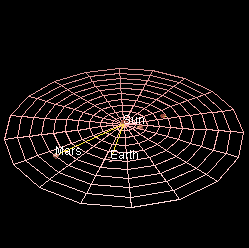Difference between revisions of "Orbit"
m (Text replacement - "http://" to "https://") |
|||
| Line 2: | Line 2: | ||
| − | In [[physics]], an '''orbit''' (or revolution) is the [[Gravity|gravitationally]] curved path of one object around a point or another [[body]], for example the gravitational orbit of a [[planet]] around a [ | + | In [[physics]], an '''orbit''' (or revolution) is the [[Gravity|gravitationally]] curved path of one object around a point or another [[body]], for example the gravitational orbit of a [[planet]] around a [https://www.wikipedia.org/wiki/Star star]. |
| − | [[History|Historically]], the [[apparent]] [[motions]] of the [[planets]] were first understood geometrically (and without regard to [[gravity]]) in terms of [ | + | [[History|Historically]], the [[apparent]] [[motions]] of the [[planets]] were first understood geometrically (and without regard to [[gravity]]) in terms of [https://en.wikipedia.org/wiki/Epicycles epicycles], which are the sums of numerous [[circular]] motions. [[Theories]] of this kind predicted paths of the planets moderately well, until [https://www.wikipedia.org/wiki/Johannes_Kepler Johannes Kepler] was able to show that the motion of the planets were in [[fact]] (at least approximately) [[elliptical]] motions. In [https://www.wikipedia.org/wiki/Isaac_Newton Isaac Newton]'s ''Principia'' (1687), Newton derived the [[relationships]] now known as [https://en.wikipedia.org/wiki/Kepler%27s_laws_of_planetary_motion Kepler's laws of planetary motion] from a [[force]]-based theory of [[universal]] gravitation.[4] Albert [[Einstein]]'s later general theory of [[relativity]] was able to account for [[gravity]] as due to curvature of [[space-time]], with orbits following [https://en.wikipedia.org/wiki/Geodesic geodesics].[https://en.wikipedia.org/wiki/Geodesic] |
[[Category: Physics]] | [[Category: Physics]] | ||
Latest revision as of 01:22, 13 December 2020
In physics, an orbit (or revolution) is the gravitationally curved path of one object around a point or another body, for example the gravitational orbit of a planet around a star.
Historically, the apparent motions of the planets were first understood geometrically (and without regard to gravity) in terms of epicycles, which are the sums of numerous circular motions. Theories of this kind predicted paths of the planets moderately well, until Johannes Kepler was able to show that the motion of the planets were in fact (at least approximately) elliptical motions. In Isaac Newton's Principia (1687), Newton derived the relationships now known as Kepler's laws of planetary motion from a force-based theory of universal gravitation.[4] Albert Einstein's later general theory of relativity was able to account for gravity as due to curvature of space-time, with orbits following geodesics.[1]
